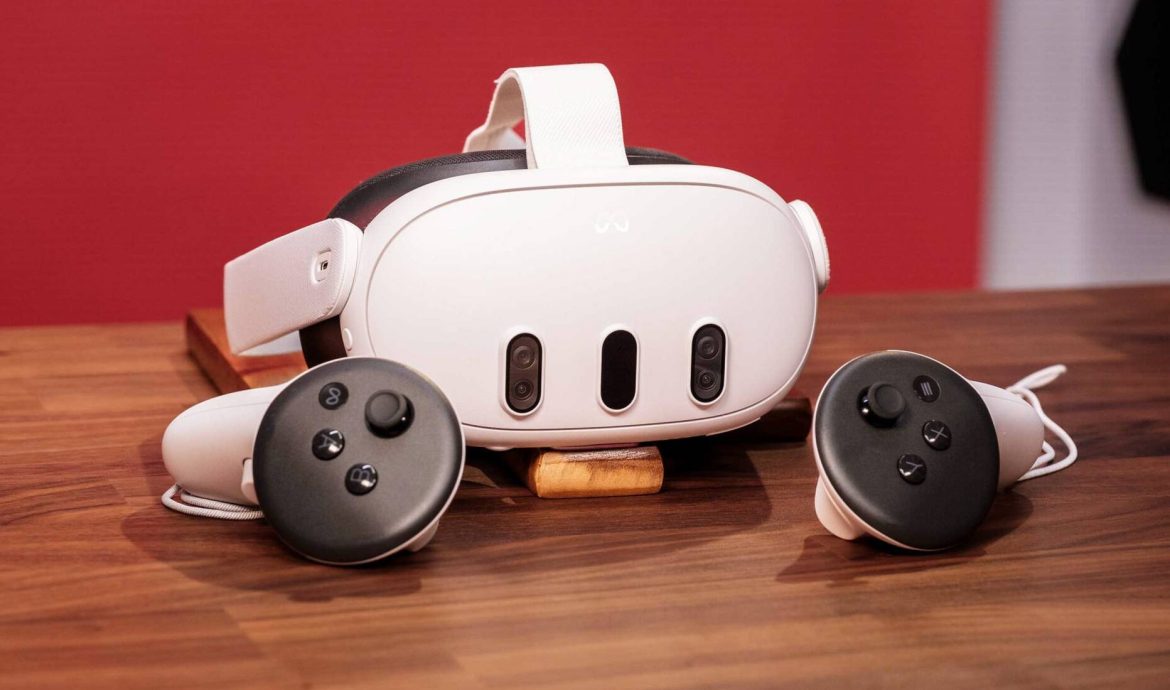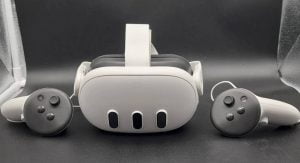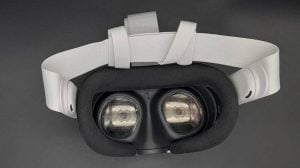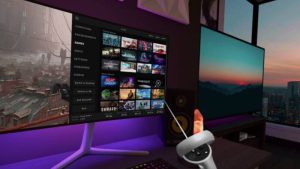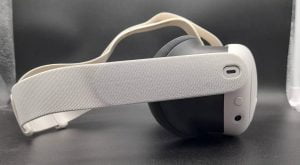Thanks to its improved passthrough experience over the Quest 2, its extensive library of games and services, and its nearly unbeatable performance at a price of around €500, the Meta Quest 3 is now the best mainstream VR headset on the market. Although the price of the Sony PlayStation VR2 is the same, you should also consider the €400 to €500 cost of the PlayStation 5 that powers this headset. Moreover, enthusiasts who want the best graphical quality are better off avoiding the PSVR2 due to its lack of PCVR support.
Key improvements
- Mixed reality: mixes both virtual and real space to add more variety for apps and gaming experiences.
- 2x better graphics than Meta Quest 2: Snapdragon XR2 Gen 2 chip provides significantly faster performance with higher-res textures and better lighting effects.
- 4K+ Infinite Display: Offers a resolution boost of nearly 30% compared to Meta Quest 2.
How I put Meta Quest 3 to the test
I have been playing with the Meta Quest 3 for many months now and have tried several VR and mixed reality games, such as Supernatural and SEGA's Samba de Amigo, as well as more mobile games like Out of Scale and Immersed. I regularly train with the Quest 3 and because of its excellent comfort and reliable physical controllers, I have found myself reaching for it more often than my Apple Vision Pro.
I always wear glasses, but fortunately my vision is not so poor that it should be a problem when using VR headsets with integrated lens adjustments. I have discovered a comfortable sweet spot with my home VR set and have been able to use the headset both with and without glasses without any problems
What qualities make the Quest 3 the best?
Thinner form factor: The thinner shape of the Quest 3 was the first thing I noticed when I got my hands on it. VR headsets are inherently front-heavy because of the many cameras and sensors needed to interpret your surroundings, especially those that are free-standing and don't require a PC or external sensors to function. Although the Quest 3 (515 g) weighs more than the Quest 2 (503 g), the headset is significantly easier to balance with the headband because of the streamlined front components, including the redesigned pancake lenses.
Touch controllers
In addition, Meta has reduced the size of the Touch Plus controllers and removed the sensor rings that sometimes made the previous model difficult to store. The improved sensors on the headset plus some AI/machine-learning improvements that can more accurately predict your hand and finger movements have made this possible, according to the company.
The new controllers have haptic properties that are considerably more realistic and also much more convenient. When games activate the most basic vibrations, they can still look like old Nokia phones buzzing, but other times they feel solid and tactile, giving me a realistic sensation when I charge a blaster or press a virtual button.
Quest 3 Cameras and sensors
More cameras and sensors: Perhaps the two additional RGB cameras and depth projector will help you realize that the Quest 3 was designed with mixed reality experiences in mind, if Meta's marketing failed to convey this to you. The new headpiece is remarkably accurate at estimating distances between objects and is better at mimicking your surroundings in full color. While it is not as good as Apple's $ 3500 Vision Pro in terms of visual fidelity, it is still more than enough for a headset with a much lower price.
These days you can map out your protection area - the area you mark as "safe to walk around in with a headset covering your eyes"- by simply moving through it and letting the cameras and sensors take care of the scaling. While it still takes some work - I strongly recommend moving around furniture such as couches and plants and looking up and down to give the headset the most realistic play area - the ability to do this without a controller is an important step toward a VR/MR world where your hands and eyes are your only controls.
Game experiences
First Encounters is a fun introductory game similar to Space Invaders, but set in a mixed reality where you have to shoot aliens that physically break through your barriers. My entire living room was turned off to gaming, so it didn't take me long to smile when I saw virtual cracks in my ceiling. I also wasn't afraid to move around a lot and bump into furniture because the passthrough was very accurate!
With the headset on, I could read and use my phone to some extent. In contrast, the Quest 2 gave intermittent infrared light and at most a luminous white rectangle.
Mixed reality provides even more variety
One of the Quest 3's main selling points is its mixed reality (MR) functionality, which allows you to bring virtual characters and objects into the real world. Meta previously offered this only in the much more expensive Quest Pro headset, so the Quest 3 offers a much more affordable entry into this type of experience. And how super they are!
In Lego Bricktales, you can get holographic overlays of the minifigs and block-shaped objects in the real world, making you feel like a Tony Stark-like as you manipulate them. In Ghostbusters: Rise of the Ghost Lord, Stay Puft rips the roof off your house and sends his ghost knocking teams at you for total mayhem! Ocean Rift VR puts your house underwater and lets sharks and other wild animals swim around you. Demeo recreates the table-top RPG experience in your living room.
A real highlight of the Quest 3 experience was discovering how developers utilize MR in unique ways beyond just shooter experiences. Highly recommended for those looking to get everything out of their headset!
At the same time, even something that is overplayed, such as zombie shooters, can become much more interesting in MR. Drop Dead: The Cabin, a wave-based zombie survival experience, is fairly fun in online co-op, but I especially liked MR's optional "Home Invasion" mode. After using the Touch controllers to manually draw doors and windows in your living space, the game starts and zombies try to break through these barriers. While it sounds gimmicky, there's something undeniably unnerving about seeing comfortable spots turn into zombie-filled death traps, and it makes moving to shoot and hack at the undead even more tactile!
Switch it up!
The ability to switch between standard VR games and games that support MR adds even more value to the Quest 3 and keeps me coming back for more.
However, there are still shortcomings to the new mixed reality experience. There were definitely times when I broke the "immersion" by waving my arms and distorting the passthrough. In addition, the true color tone can be cooler than how something looks in real life. Still, for $500, it's still a significant upgrade that many people will find attractive.
Quest 3 New lenses
Pro-tier pancake lenses: Consumers will be pleased to hear that the Quest 3 now comes with 4K+ Infinity Display pancake lenses, which are available on Meta's more expensive VR headset for nearly a third of the price the Quest Pro originally charged. This greatly improves the sharpness and detail of text and images, in addition to increasing the field-of-view (FOV), or how much of the screen you can see from one angle to another. The most obvious improvement was when I used the Immersed app to work on my virtual desktop. It took me less time than browsing around normally.
The new processor
Qualcomm Snapdragon XR2 Gen 2: This platform, which claims to deliver two times faster graphics performance than the Quest 2, drives the screens and the system as a whole. I spent a good hour testing the load times of several games on both headsets, including Beat Saber, Superhot VR, Onward and others, because the Quest 3 is backwards compatible, meaning it can run applications and games currently available for the Quest 2. Everything runs smoother and the whole thing just feels much faster than its predecessor!
Faster render: The Quest 3 rendered images 4-5 seconds faster, even though it didn't exactly work twice as fast. Of course, you can only tell this difference if you compare the two devices side by side.
Quest 3 Audio
Better spatial audio: I didn't think the Quest 3's audio would be among my favorites, but it is. The headset has surround sound technology called 3D spatial audio, which raises the bar for virtual and mixed reality experiences. The best example of this update occurred during my demo of Dungeons of Eternity, when I was too busy exploring the cave and admiring how the visuals had been produced to pay attention to the dungeon master explaining the tricks of the trade to me 😉
Where is the 256GB version?
One thing about the Quest 3 that I still wish Meta had done differently is a 256GB version. Right now the headset is limited to 128GB and 512GB capacity, so you have to make do with just enough storage or possibly too much. My used space stands at 113GB of the 128GB with about 22 games downloaded, including more graphically demanding games like Asgards Wrath 2. To make the best purchase choice, if you plan to purchase a Quest 3, I would keep in mind carefully how much storage your favorite apps and games need.
What I hope to see in the upcoming version
Eye control: Since the Quest headset was first released with the Snapdragon XR2 Gen 2 processor, I hope Meta will include eye-tracking in the future version of the headset. This would allow for more realistic interactions with social apps such as Horizon Worlds and easier UI navigation. In his brief review of the Vision Pro, Mark Zuckerberg stated that "Apple's eye tracking is really nice, we had those sensors in the Quest Pro...we're going to bring them back in the future." So this is not entirely implausible.
The most logical next step for the base model would be to include the functionality of the Quest Pro, which would allow for more flexible control and responsive input.
4K display resolution: The Apple Vision Pro is proof that media consumption can surpass all other VR use cases with only a high-resolution display, immersive speakers and possibly Disney support. While absolutely plausible, I don't claim that a Quest set with 4K displays will ruin Apple's fun. Sharper, more pixel-accurate projection would improve almost any Quest experience, including working, gaming and watching movies.
Conclusion
All this is to say that the Meta Quest 3 is the best in its price range, as is the Quest 2 in the 200-300 price range. Nevertheless, if consumers choose to experiment with virtual and mixed reality, even die hard enthusiasts and advanced users should consider the latest Meta headset.
This year I hope to see Meta go one step further; perhaps even bring back the Pro line and make a high-end model that competes with the Apple Vision Pro, but has more useful capabilities for a growing VR market. Because the company that re-brands itself to the metaverse is the company that best understands the inclinations of virtual reality users.

